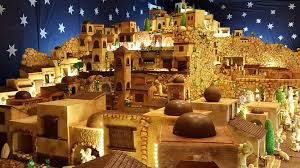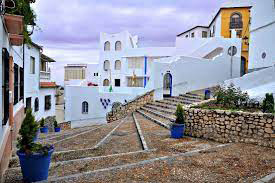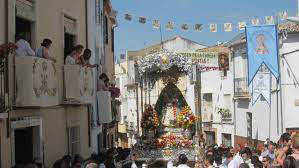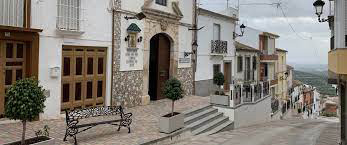Rute
Rute
Municipio situado al sureste de la provincia, en las Sierras Subbéticas, incluido en el Parque Natural de la Sierra Subbética, que presenta un relieve de fuertes elevaciones calizas y valles poblados de encinares, quejigales y álamos blancos en las riberas de los cursos de agua. La agricultura tiene como principal actividad el cultivo del olivar. En su término se encuentra parte del embalse de Iznájar, que aporta al paisaje un elemento de gran interés paisajístico.
El pueblo se extiende al pie de la Sierra de Rute, formado por calles en cuesta, de casas blancas y limpias, ofreciendo un conjunto muy atractivo e integrado en el entorno. Es conocido, además, por la elaboración de licores y aguardientes.
Historia
Su nacimiento es probablemente árabe. De la antigüedad del lugar hablan sus lápidas y sepulcros romanos encontrados en la villa, aunque de la época prehistórica hay documentados dos yacimientos: La Cueva Negra y El Camorro.
Está bajo el dominio musulmán hasta 1240 en que es conquistada por Fernando III, volviendo a perderse para ser reconquistada por Alfonso XI que la puebla con cristianos. Hacia 1315 en las guerras civiles de Castilla queda desguarnecida la villa, siendo atacada por Ozmir que la conquista y mantiene hasta 1341. Volverá a perderse y será conquistada definitivamente por Ramir Sánchez de Barrionuevo, a quien se la entrega en merced el Rey Juan II(1434).
Ramir Sánchez traslada el sitio de la población al lugar que actualmente ocupa.
El hijo de Ramir Sánchez perderá el señorío de Rute por deslealtad a la Corona, entregándosela Enrique III en 1466 a Diego Fernández de Córdoba, Conde de Cabra, como recompensa por la ayuda prestada en la toma de Écija; Juan Fernández de Córdoba, deán de la Catedral de Córdoba, heredará la villa como mayorazgo unido a los señores de Baena y condes de Cabra y Sesa.
Personajes destacados
Mariano Roldán, poeta y periodista (1932).
Juan de Aguilar, pedagogo (1577-1634).
Alfonso de Castro Hurtado, gobernante (1732-1799).
El Museo del Azúcar Por Navidad y en Rute, ciudad artesana y confitera de la Subbética, el Museo del Azúcar de La Flor de Rute se ha convertido en visita indispensable.
Fundado hace más de tres lustros, presenta más de treinta piezas de azúcar y considerable tamaño, que incluyen reproducciones de monumentos de Andalucía, el Castillo de Euro Disney o la Basílica de San Pedro. A estas azucaradas edificaciones se suman figuras a tamaño natural de la Duquesa de Alba o de pintores, como Picasso o Dalí, además de diferentes y dulces cuadros, carteles publicitarios o una reproducción de la copa del mundo de fútbol, todo hecho de azúcar.
Pero el Museo del Azúcar es mucho más: vuelva al pasado con la recreación de una antigua fabrica de mantecados mientras pasea entre utensilios, maquinaria antigua o curiosidades, como los autógrafos de consumidores ilustres (Rafael Alberti, Florinda Chico, Camilo José Cela, Julia Otero o Siempre Así). Disfrute la degustación gratuita que se ofrece a los visitantes, vea cartas de felicitación llegadas desde Japón, Cuba, Australia o Estados Unidos y no se sorprenda si en algún momento se encuentra con alguno de los famosos y variopintos personajes que ya nos han visitado.
Museos del aguardiente anisado de Rute y España Localizados en Rute, los 'Museos del aguardiente anisado de Rute y España' exponen la verdadera historia de la bebida más importante del mundo, puesto que se ha fabricado en más de 3.000 pueblos en toda España, en más de 10.000 destilerías y, por supuesto, con más de 20.000 marcas diferentes de anises.
La base de los museos es la exposición de 8.000 piezas y 6.000 marcas de anises aunque, en cualquier momento, los visitantes podrán ver piezas nuevas, pues actualmente sólo exponen un 25% del total de los fondos que poseen sobre esta bebida.
Los Museos del aguardiente anisado de Rute y España ofrecen también algo diferente: la historia de la cartelería española, la historia de la botella, de la etiqueta litográfica, de los litógrafos, artes gráficas y la publicidad (lo que hoy conocemos como mercadotecnia o “marketing” español).
Los museos tienen representadas las 52 provincias españolas e, incluso, las antiguas colonias nacionales.
Cuentan con guía especializado y aparcamiento en los aledaños de los museos.
Exponen, entre otros datos curiosos, el primer cartel hecho en España con una fecha inédita para los historiadores: 1820; pedidos de aguardiente en Reales de Vellón, los más antigüos que se conocen (1846); y la botella más antigua de aguardiente de vino puro que actualmente existe en el mundo. Así hasta las 8.000 piezas de sobresaliente interés.
En Rute, la Casa Museo del Jamón de Jamones Rute es un sueño hecho realidad. La empresa fue fundada por la familia Jiménez hace más de 60 años y, durante todo este tiempo, ha ido almacenando los diferentes útiles que han quedado en desuso por los avances técnicos. Hoy forman una excelente y fiel exposición de la historia de la charina y la elaboración del jamón más artesano.
El respeto por la tradición y el amor por estas "faenas", han dado fruto a un excelente museo que recopila todo el utilllaje relacionada con esta actividad.
El Museo del Jamón cuenta con varios y muy bellos mosaicos de cerámica que representan escenas artísticas relacionadas con esta actividad, como la "matanza" del cerdo. Fueron creadas por el artista Tomás Egea Azcona.
"... y si la convalescencia la sufre, unas lonjas de jamón de Rute, nos harán la salva", Miguel de Cervantes "El Casamiento Engañoso"
Destilerías Machaquito te propone una inmersión en un conjunto de experiencias y vivencias que activarán tus sentidos y te harán viajar por la historia del arte de elaborar destilados, desde sus comienzos hasta hoy día, cuando esta prestigiosa destilería de Rute está a la vanguardia del sector.
#venYverás... el fuego de las calderas, con 2 toneladas de leña de olivo calentando 4 gigantescos y centenarios alambiques de cobre que, en ciclos de 24 horas, destilan el inimitable Anís de Rute.
Durante la visita podrás conocer la sala de alambiques, la nave de maceración de licores, la sala de embotellado, la sala de degustación, la leñera y la Exposición Machaquito.
De su diversa oferta destacan las catas a la carta de licores y combinados y el catering a la carta para celebrar eventos. Ambas con reserva requerida.











